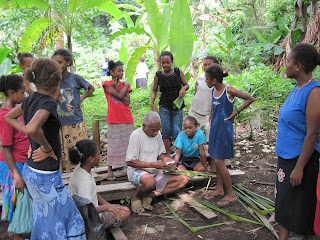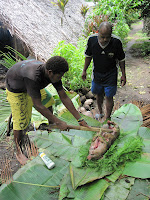Volovuhu School has grown in the past 2 years to include year 7 and 8 students. We are now Volovuhu Center School as opposed to primary school. In the future the school committee would like to grow to include year 9 and 10 as well. One challenge for outer islands is that the students have to walk longer distances to get to school. Our school decided to build dormintories to give the year 7 and 8 students places to sleep so that during the week they could focus more on their studies and not have to worry about walking to and from school.
In one of my earlier posts I showed you how I learned to weave natanguras leaves into thatched roofing. One day the community was working on the dormitories and I came along to see what they were up to.
They had built up the frame of the house already.
Before the natanguras can be put onto the roof the vines have to be prepared. A group of youngfalas brought heaps of vines from the bush. We then tediously split the big ones down the middle to make them easier to use.
Bubu Fred (my grandpa...blue shirt), Bubu Edward (my grandpa...black shirt) and Bubu Fred's "Tawi" (brother-in-law...grey shirt) are reinforcing the ends of the natanguras that will be on the edges of the roof. The normal natanguras are only woven with the stem of coconut leaves. These edges get woven again with bamboo which is stronger. The reason they do this is to help the thatched roofing hold up on windy days.
 Before the natanguras are sown onto the bamboo frame, a namele leaf is placed around the roof. These leaves are custom to provide protection over the house.
Before the natanguras are sown onto the bamboo frame, a namele leaf is placed around the roof. These leaves are custom to provide protection over the house.  Before the dormitory was complete the community members helping taught some students how to "sowemap" the natanguras onto the roof during a cultural learning afternoon.
Before the dormitory was complete the community members helping taught some students how to "sowemap" the natanguras onto the roof during a cultural learning afternoon.When the dormitory is complete I will post more pictures!







































 Papa used coconut leaves to weave/braid around the pig so that it would not burn while baking in the hot stones.
Papa used coconut leaves to weave/braid around the pig so that it would not burn while baking in the hot stones.










